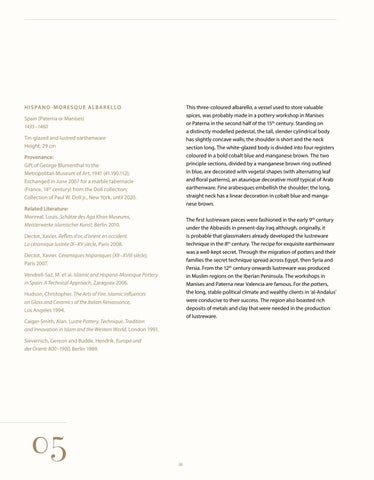H I S PA N O - M O R E S Q U E A L B A R E L L O
This three-coloured albarello, a vessel used to store valuable spices, was probably made in a pottery workshop in Manises or Paterna in the second half of the 15th century. Standing on a distinctly modelled pedestal, the tall, slender cylindrical body has slightly concave walls; the shoulder is short and the neck section long. The white-glazed body is divided into four registers coloured in a bold cobalt blue and manganese brown. The two principle sections, divided by a manganese brown ring outlined in blue, are decorated with vegetal shapes (with alternating leaf and floral patterns), an ataurique decorative motif typical of Arab earthenware. Fine arabesques embellish the shoulder; the long, straight neck has a linear decoration in cobalt blue and manganese brown.
Spain (Paterna or Manises) 1435 –1460 Tin-glazed and lustred earthenware Height: 29 cm Provenance: Gift of George Blumenthal to the Metropolitan Museum of Art, 1941 (41.190.112); Exchanged in June 2007 for a marble tabernacle (France, 14th century) from the Doll collection; Collection of Paul W. Doll jr., New York, until 2020. Related Literature: Monreal, Louis. Schätze des Aga Khan Museums, Meisterwerke islamischer Kunst, Berlin 2010.
The first lustreware pieces were fashioned in the early 9th century under the Abbasids in present-day Iraq although, originally, it is probable that glassmakers already developed the lustreware technique in the 8th century. The recipe for exquisite earthenware was a well-kept secret. Through the migration of potters and their families the secret technique spread across Egypt, then Syria and Persia. From the 12th century onwards lustreware was produced in Muslim regions on the Iberian Peninsula. The workshops in Manises and Paterna near Valencia are famous. For the potters, the long, stable political climate and wealthy clients in ‘al-Andalus’ were conducive to their success. The region also boasted rich deposits of metals and clay that were needed in the production of lustreware.
Dectot, Xavier. Reflets d’or, d’orient en occident. La céramique lustrée IX – XV siècle, Paris 2008. Dectot, Xavier. Céramiques hispaniques (XII – XVIII siècle), Paris 2007. Vendrell-Saz, M. et al. Islamic and Hispano-Moresque Pottery in Spain: A Technical Approach, Zaragoza 2006. Hudson, Christopher. The Arts of Fire. Islamic Influences on Glass and Ceramics of the Italian Renaissance, Los Angeles 1994. Caiger-Smith, Alan. Lustre Pottery, Technique, Tradition and Innovation in Islam and the Western World, London 1991. Sievernich, Gereon and Budde, Hendrik. Europa und der Orient: 800 –1900, Berlin 1989.
05
38














